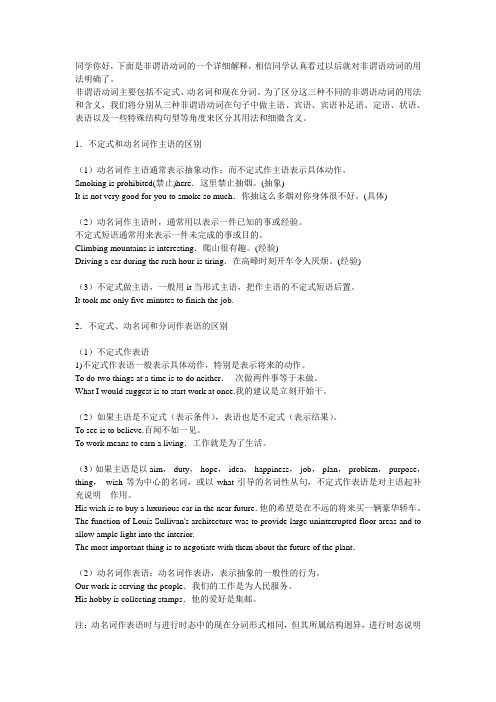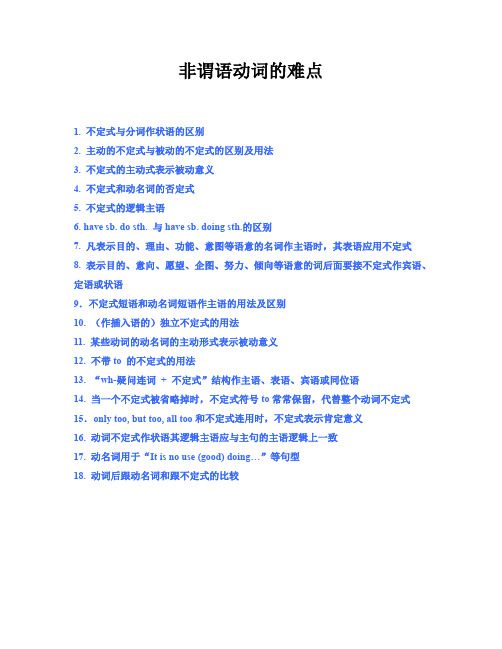不定式和分词作状语的区别
不定式和现在分词作结果状语的区别

不定式和现在分词作结果状语的区别
不定式和现在分词均可用结果状语,但两者用法有区别:
(1) 现在分词用作结果状语
通常表示一种自然的结果,即属预料之中的事。
如:
He died, leaving his wife with five children. 他死了,留下他妻子和五个儿子。
The child fell, striking his head against the door and cutting it. 那孩子跌倒了,头碰在门上磕破了。
(2) 不定式用作结果状语
主要表示没有预料到的情况或结果,即属预料之外的事。
该用法通常与副词only连用。
如:
He lifted a rock only to drop it on his own feet. 他搬起石头砸了自己的脚。
He hurried to the house only to find that it was empty. 他急忙赶到那所房子,却发现空无一人。
She got there only to be told that they had gone on holiday. 她到达那里,被告知他们度假去了。
注意:并非所有表示结果的不定式都含有这种“意外”的效果。
如:
What have I done to offend you. 我干什么惹你生气了?
The tea is too hot to drink. 茶太热,不能喝。
非谓语动词作状语讲解(学生版)

非谓语动词不定式和分词作状语一、不定式作状语可以作:1.主要用作。
常与连用。
so as to 不用于居首。
He got up early in order to catch the first bus. 。
He sat down to have a rest.He went to France to learn French。
2.状语。
表示的结果。
做结果状语的不定式只能出现在句子的He hurried to the station only to find the train gone.3.表示喜怒哀乐的形容词作表语其后的不定式作状语。
表示引起这种情绪变化的原因。
I’m sorry not to have come on Tuesday.I am very glad to see you.We are glad to hear the news.二、不定式做状语时应该注意:1.not/never too…to do, too…not to do, but/only too… to do, too ready to do, too eager to do表示肯定意义。
He is too careful not to have noticed that.I am only too glad to help you.I am only never too glad to know you. He is only too ready to help others, seldom, if ever, refusing them when they turn to him.2.不定式做状语时,其逻辑主语一般为,否则用for引导主语。
We studied hard to pass the exam. 不定式做目的状语其逻辑主语是we。
Li Ming’s mother went to the lecture hall early for him to get a good seat.三、分词作状语可以作:1.Hearing the noise, I turned round.Having done my shopping, I returned home.2.Not having received a reply, he decided to write again.Reading attentively,he forgot the time for lunch.3.Reading carefully,you'll learn something new.Working hard, you will surely succeed.4.They stood by the roadside talking about the plan.The boy sat in front of the farm house cutting the branch.He came running back to tell me the news.5.A lot of good land has gone with them, leaving only sand.A hurricane hit this area last night, blowing down a lot of trees.四、现在分词与过去分词作状语的区别。
动词不定式详解 do todo doing done 解析

同学你好,下面是非谓语动词的一个详细解释,相信同学认真看过以后就对非谓语动词的用法明确了。
非谓语动词主要包括不定式、动名词和现在分词。
为了区分这三种不同的非谓语动词的用法和含义,我们将分别从三种非谓语动词在句子中做主语、宾语、宾语补足语、定语、状语、表语以及一些特殊结构句型等角度来区分其用法和细微含义。
1.不定式和动名词作主语的区别(1)动名词作主语通常表示抽象动作;而不定式作主语表示具体动作。
Smoking is prohibited(禁止)here.这里禁止抽烟。
(抽象)It is not very good for you to smoke so much.你抽这么多烟对你身体很不好。
(具体)(2)动名词作主语时,通常用以表示一件已知的事或经验。
不定式短语通常用来表示一件未完成的事或目的。
Climbing mountains is interesting.爬山很有趣。
(经验)Driving a car during the rush hour is tiring.在高峰时刻开车令人厌烦。
(经验)(3)不定式做主语,一般用it当形式主语,把作主语的不定式短语后置。
It took me only five minutes to finish the job.2.不定式、动名词和分词作表语的区别(1)不定式作表语1)不定式作表语一般表示具体动作,特别是表示将来的动作。
To do two things at a time is to do neither.--次做两件事等于未做。
What I would suggest is to start work at once.我的建议是立刻开始干。
(2)如果主语是不定式(表示条件),表语也是不定式(表示结果)。
To see is to believe.百闻不如一见。
To work means to earn a living.工作就是为了生活。
(3)如果主语是以aim,duty,hope,idea,happiness,job,plan,problem,purpose,thing,wish等为中心的名词,或以what引导的名词性从句,不定式作表语是对主语起补充说明作用。
非谓语动词的难点

非谓语动词的难点1. 不定式与分词作状语的区别2. 主动的不定式与被动的不定式的区别及用法3. 不定式的主动式表示被动意义4. 不定式和动名词的否定式5. 不定式的逻辑主语6. have sb. do sth. 与have sb. doing sth.的区别7. 凡表示目的、理由、功能、意图等语意的名词作主语时,其表语应用不定式8. 表示目的、意向、愿望、企图、努力、倾向等语意的词后面要接不定式作宾语、定语或状语9.不定式短语和动名词短语作主语的用法及区别10. (作插入语的)独立不定式的用法11. 某些动词的动名词的主动形式表示被动意义12. 不带to 的不定式的用法13. “wh-疑问连词+ 不定式”结构作主语、表语、宾语或同位语14. 当一个不定式被省略掉时,不定式符号to常常保留,代替整个动词不定式15.only too, but too, all too和不定式连用时,不定式表示肯定意义16. 动词不定式作状语其逻辑主语应与主句的主语逻辑上一致17. 动名词用于“It is no use (good) doing…”等句型18. 动词后跟动名词和跟不定式的比较1. 不定式与分词作状语的区别不定式作状语时,只用来表示目的、原因和结果,其位置常常在被修饰词或句子的后面。
分词作状语时,可表示时间、原因、条件、让步、结果、目的、方式或伴随情况,其位置常常在被修饰词或句子的前面。
下面从两者都能充当的几种成分来看一下它们的区别。
1. 不定式与分词作状语的区别A. 作原因状语分词作原因状语时常位于句首或在主谓之间,在意义上相当于一个原因状语从句,强调这个原因。
不定式作原因状语时,常位于句子后面,主句中的谓语动词多是表示内心活动的词,其后的不定式说明他们产生的原因。
e.g. Being poor in health, he retired at the age of fifty.Lost in the strange city, poor Bill fell to cry.He seemed surprised to meet us.I’m happy to hear the news.B. 作结果状语分词作结果状语常由thus引起。
名校版高考英语长难句分析 现在分词和不定式作状语的区别

名校版高考英语长难句分析现在分词和不定式作状语的区别①She fell off the bike, breaking her left leg.②He studied hard only to find he had failed the exam.语法/单词/短语1.本次又是两句话,同样都是主从复合句,同样都是句子中有一个结果状语从句。
2.第一句是现在分词做结果状语从句,她从自行车上摔了下拉,所以摔断了左腿。
3.第二句是他非常努力的学习,不料他却考砸了。
这个结果状语是一种出乎意料的结果。
4.only,adv.只有;只;仅;仅在…情况下(或地点等);只不过;仅…而已;(直到)…才;仅此而已;只会,愈加;不料。
这里取的是不料这个意思。
5.动词不定式在句中充当状语,表示目的、结果、原因等。
6.表目的比较常见,比如in order to, so as to, so (such) ... as to等等7.表原因,比如I‘m glad to see you. 我很高兴见到你。
在这种主系表的结构中做形容词的原因,我为什么很高兴啊,因为见到了你这个动作,因为to do这个动作而导致了某种情绪。
8.做结果状语,我们比较常见的就是在前面加only,表示一种出乎意料的结果,特别是谓语动词是learn, find, see, hear 的时候。
咱们的例子中就是find。
9.另外很多时候不定式以被动语态出现,表示结果,例如:Dinosaurs have completely died out on the earth, never to be seen again.After singing some songs, the competitors danced onto the green field, waving their arms in the air as if they were eagles.语法/单词/短语1.主从复合句,主句为一般过去时态,含有一个as if引导的非真实条件状语从句(虚拟语气)2.介词after连接动名词做时间状语3.介词onto,(与动词连用,表示朝某处或某位置运动)向,朝;朝向,面向(某个方向),理解这个介词,可以分拆成两个介词on和to,既有肢体的接触,又表示一种方向4.现在分词waving表示伴随状语,表达比赛者们手舞足蹈的状态5.as if引导条件状语,只不过这个条件不是真实条件,而是虚拟条件。
不定式做结果状语与现在分词做结果状语的区别

不定式做结果状语的两个特点: 1. 不定式呈现出的结果与前面事实没有因果 关系。 火车开走跟他跑得快慢没有关系。
他哥哥不回家不是因为10年前离开家,而是 因为其他我们不知道的原因。
2. 不定式呈现出的结果,不是人们愿意接受 的。 他赶到车站火车开走了,他很失望的。 他哥哥离家不归,很让人伤心。
1.He cut off the electricity at once, preventing a terrible acci killing all the passengers aboard.
现在分词呈现出的结果与前面事实有直 接的因果关系。 就是因为他眼疾手快,才没出大事。 就是因为飞机失事,乘客们才丧命了。
He hurried to the booking only to be told office,______________(tell) the tichets had been sold out.
More highways has been built, making _________(make) it more convenient for people to travel around China.
110而他哥哥不回家不是因为年前离开家而是因为其他我们不知道的原因
不定式做结果状语与
现在分词做结果状语 的区别
1.He rushed to the railway station, only to find that the train had left.
2.His brother left home 10 years ago, never to return.
不定式,动名词和分词的区别
不定式和动名词作主语区别1.含义上的不同。
不定式一般表示特定的,具体的行为,特别是表示将来的,或一次性的行为。
如:To write a new book about medicine is his wish. 写一部医学方面的新书是他的愿望。
(将来的动作) It took me two hours to finish this work today. (表示一次性的动作)动名词表示一般的事实Raising pigs is her job. 养猪是她的工作。
2. 结构上的不同。
在一些固定的句子中动名词It’s no use doing It is useless doing 做……无用It’s no good doing It’s no help doing 做……无用,无益There be 句型 There is no joking about such matter.不定式It isn’t easy to do I have no time to do不定式复合结构 It is + adj.+ of/for sb + to do It is very kind of you to help me.代词+不定式结构 Mary’s coming late made him angry.疑问词+不定式 Where to hold the meeting has not been decided.It’s time for sb to do3. 主语和表语同时使用要一致To live is to learn.Reading is learning.不定式、动名词和分词作表语区别1.动名词和不定式相当于一个名词,分词相当于一个形容词。
2.不定式、动名词与分词作表语的区别。
不定式和动名词作表语相当于一个名词作表语,含义是回答主语“是什么”;分词作表语相当于形容词作表语,含义是回答主语“怎么样”。
如:① Our plan is to keep the affair secret. 我们的计划是让这件事成为秘密。
不定式和现在分词做状语的区别
不定式和现在分词做状语的区别不定式和现在分词,这俩家伙在英语里可真是“各有千秋”。
就拿不定式来说吧,很多人觉得它像是一只小鸟,轻轻松松就飞到句子里,传达着一个目的。
比如说“我去超市买东西”,这不就是个简单明了的不定式嘛!它的作用就像是给我们设定了一个小目标,哦,对了,像是在发出一个邀请:嘿,快来加入我吧!听起来是不是有点可爱呢?而现在分词就有点像那种百事通的小伙伴,既能陪你聊天,又能帮你忙。
想象一下“我看到他跑得飞快”,这里的“跑得飞快”就是个现在分词,形象地描绘出他的状态。
它不仅在句子里负责描述动作,还让画面变得生动起来。
像在描述一个场景时,现在分词就好比是给画面加上了特效,让我们感受到那种“活生生”的气息。
简直让人想大喊一声:“哇,太炫了!”但是,得注意哦,这俩小家伙可不能随便混淆。
很多人会在句子里把它们搞混,结果就搞得一团糟。
比如说,“她喜欢游泳”用的不定式是“to swim”,而“她在游泳”则得用现在分词“swimming”。
你说这两者之间的区别是不是让人感到恍惚?就像有时候你一边吃东西,一边玩手机,结果到头来,你不知道自己吃了什么,感觉好尴尬。
咱们说到不定式的时候,它还有个大杀器,那就是可以表达未来的意图。
这就像是“我打算去旅行”,这里的“去旅行”就给我们一个未来的指引。
而现在分词呢,它更像是在描述正在发生的事情,给人一种“此时此刻”的感觉,像是电影里的慢动作回放,抓住那一刹那的美好。
我们常说“时光飞逝”,可是现在分词却在提醒我们:“嘿,别忘了享受现在的美好哦!”这俩角色在句子里就像是一对好搭档,各自发挥着自己的作用。
不定式那种简洁利落的感觉,像是初春的阳光,温暖而清新;而现在分词则像是夏日的风,轻柔而自在。
你有没有觉得,它们的存在让句子变得更加丰富多彩?就像调色板上的颜色,缺一不可。
一个句子如果只用一种形式,那简直就像是一道没有调味的菜,乏味无趣,谁会愿意尝呢?所以说,掌握不定式和现在分词,就好像学会了调配各种口味的秘方,能让你的表达更加生动。
现在分词与不定式作结果状语时的区别
现在分词与不定式作结果状语时的区别请看高考题:1. European football is played in 80 countries , _________ it the most popular sport in the world .A. makingB. makesC. makeD. to make2. He hurried to the station only ________ that the train had left .A. to findB. findingC. foundD. to have found这两个题的答案分别是:1. A 2. A。
很显然,从题干来看,所选答案表示的都是结果,其动词不定式和现在分词在句中都作结果状语。
那么,两者的区别又怎样呢?现归纳总结如下:一. 现在分词作结果状语时一般只能单独使用,也就是说,没有固定的句型结构,它通常位于句末,其前有逗号隔开,有时为了突出结果之意可在现在分词前加副词thus,常译为“因而”、“所以”等。
现在分词作结果状语往往表示“正常出现的、自不过然的或意料之中”的结果。
例如:The enemy opened fire , killing one of our guards . 敌人开枪了,结果打死了我们一名卫兵。
Her husband died in 1942 , leaving her with five children . 她的丈夫在1942去世了,结果给她留下了五个孩子。
但应注意:现在分词作结果状语时,其逻辑主语能够是句子的主语,也能够是整个句子。
例如:By 1820 the population of New York had grown to about 125,000 , making it the largest city in the USA . 到1820年纽约的人口增长到大约125,000人,结果使它成为美国最大的城市。
分词短语作状语以及不定式作状语
1.什么是状语:修饰动词、形容词、副词等及其短语或整个句子,说明动作或特征的句子成分,叫做状语。
2.状语的表现形式:(1)副词及其词组(2)介词短语(3)不定式(短语)考而感到自豪。
(4)分词(短语)主语一直可以省略决定去向老师寻求意见。
我决心把英语学好。
(5)名词(短语)加努力学习。
3.状语的分类(1)时间状语6:00再见面怎样?下雨天我通常乘公共汽车去学校。
(2)原因状语由于下雨,她昨晚没有去参加舞会。
Since you are very busy, I won’t trouble you.既然你很忙,我就不打扰你了。
(3)条件状语如果不下雨,我将到那里去。
你就可以在英语方面取得快速的进步。
(4)方式状语的英语水平。
(5)伴随状语老师走了进来,后面跟着一群学生。
(6)目的状语(7)结果状语He was so tired that he fell asleep immediately.他累极了,立刻就睡着了。
He is so good a teacher that the students love and respect him.他是一位很好的老师,学生们都敬爱他。
(8)让步状语欢迎。
(9)程度状语(10)比较状语I am taller than he is.我比他高。
4.分词短语作状语的用法(高考重点)(1)分词短语做状语的句法功能分词或分词短语作状语时,可以表时间、原因、结果、条件、让步、行为方式、伴随状况等。
表示时间关系的分词短语有时可由连词while或when引出。
Hearing the news, they got excited.(时间)听到这个消息,他们很兴奋。
Be careful while/when crossing the street.(时间) 过街口时,一定要小心。
Having been bitten by a snake, she was frightened at it.(原因)由于被蛇咬过,她很怕蛇。
- 1、下载文档前请自行甄别文档内容的完整性,平台不提供额外的编辑、内容补充、找答案等附加服务。
- 2、"仅部分预览"的文档,不可在线预览部分如存在完整性等问题,可反馈申请退款(可完整预览的文档不适用该条件!)。
- 3、如文档侵犯您的权益,请联系客服反馈,我们会尽快为您处理(人工客服工作时间:9:00-18:30)。
不定式分词作状语区别
不定式作状语可以表如: To look at him, you would like him.
分词也可以作状语表如:Given a chance, I can surprise the world.
但不定式作状语与分词作状语的区别是什么不明白可以互换么例如上面这两句
不定式作状语可以作
1)目的状语He sat down to have a rest.他坐下来休息。
(坐下来的目的是为了休息)
He went to France to learn French。
他去法国学习法语。
They 他们停下来问路。
2
He work up to find everybody gone. 他醒来发现大家都走了to find everyb ody gone作work up的结果状语。
3)表示喜怒哀乐的形容词作表语其后的不定式作原因状语
I am very glad to see you. 见到你我非常高兴。
(to see you 作glad的原因状语)
4)在带有enough或too的句子里,不定式作程度状语
He is old enough 他到上学年龄了。
5)动词不定式可以作目的in order to (为了)或so as to (以便)+do。
(so as to
He got up early
In order to catch
分词作状语
1)作时间状语
Hearing the noise, I turned round. 听见响声我转过身去。
I returned home. 买完东西,我就回家了。
2
Being League members , are ready to help others. 由于我们是团员,我们乐意帮助别人。
Not knowing his address, I can’t write to him由于不知道他的地址,我无法给他写信。
3)表示条件
Working hard, you will surely succeed. (=If you work hard, you…)如果你努力工作,你就一定会成功。
Given more time, we could have done it better. (If we had been given mo re time, …)如果给我们时间多一些,我们本来会做得更好。
4)表示伴随或方式
The boy sat in front of the farm house cutting the branch. 那男孩坐在农舍前,小树枝。
(伴随)
He came running back to tell me the news. 他跑回来告诉我这个消息。
(方式)
5)表示结果
The child slipped and fell, hitting his head against the door.那孩子滑了一跤,头撞到了门上。
分词和不定式作状语一般是不可以换的
动词不定式作结果状语,表示出乎意料的结果,而用现在分词作结果状语表示自然的结果。
并且,充当结果状语的现在分词的逻辑主语有时并不是句子的主语,而是句子的内容或部分内容。
He hurried to the station only to find the train gone. 他匆匆忙忙地赶到火车站,发现火车已经开走了。
A lot of good land has gone with them , leaving only sand. 许多好地也随之消失了,留下来的只是沙漠。
不定式表示原因时,往往置于形容词之后,表示引起某种情绪变化的原因。
分词表示原因时,往往位于句首,表示发生某一行为的原因。
I’m sorry not to have come on Tuesday. 很抱歉没有在星期二来。
Not having received a reply, he decided to write again. 没有收到答复,他决定再写一遍。
